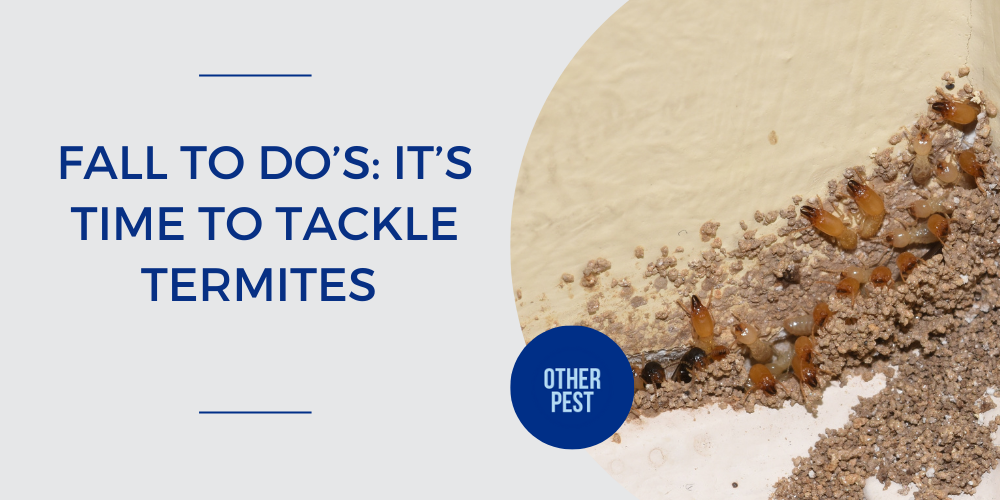As Arizona’s temperatures finally begin to cool and residents gear up for the lively winter and holiday season ahead, it’s easy to put pest control initiatives off. Termites are pests that tend to go under the radar, causing unnoticeable damage until it is too late. Yet, they are among the most destructive pests in Arizona, and despite the cooler weather, their activity doesn’t slow during fall and winter. It is crucial to remain aware of the signs of termites and how to protect your homes from these wood-destroying insects.
Termite Activity in Arizona
Although termites tend to be most active during spring and summer, Arizona’s mild winter temperatures provide an ideal environment for termites to continue eating and consuming wood year-round. Arizona is home to a variety of termite species, the most common being subterranean termites and drywood termites:
Subterranean termites build their colonies in the soil and create mud tubes to access above-ground food sources, such as wood in homes and buildings.
Drywood termites don’t need soil contact and can infest wood directly, often nesting inside wooden furniture, beams, or flooring.
In both species, the threat to Arizona homes is substantial. Termites feed on cellulose, which is found in wood, paper and plant materials, and can cause significant structural damage if left unchecked.
Fall Termite Prevention
As autumn sets in and the holiday season approaches, homeowners are consumed with holiday preparations, hosting guests and decorating. Unfortunately, busy social schedules leave little time for home maintenance and the potential for overlooking warning signs of a termite invasion. Homeowners must prioritize time to perform regular home inspections. Check wood structures in and around the home to ensure everything is in good condition.
Signs of Termite Activity
Identifying termites early is essential for minimizing damage. The longer an infestation goes unnoticed, the more costly and extensive repairs can become. Here are some common signs of termite activity to look out for:
Mud Tubes: Subterranean termites create mud tubes, which are small, dirt-like tunnels used to travel between their colonies in the soil. You might notice these tubes on your foundation, walls or crawl spaces.
Hollow Wood: Termites eat wood from the inside out. If you knock on wood structures in your home and they sound hollow or give way easily, termites could be the reason.
Termite Droppings: Drywood termites produce small, pellet-like droppings called frass. If you find these near wooden structures, it’s a strong indicator of termite activity.
Bubbling or Warped Wood: Termites can cause wood to blister, bubble, or warp as they consume it from the inside. Doors, windowsills and wooden beams are common areas where you may notice this damage.
Discarded Wings: In some cases, subterranean termites will swarm or leave to establish new colonies. You may find discarded bug with wings near windows or door frames where swarms have occurred in the past.
Tight Fitting Doors and Windows: Difficulty in opening or closing doors and windows could be another sign of termite activity. As termites consume wood, they generate moisture within it, causing the wood to swell. This swelling can result in doors and windows that fit too tightly, making them harder to operate.
How to Prevent Termites
By taking proactive steps and implementing simple strategies, you can reduce the risk of a termite invasion and the destruction they inevitably cause. Below we have outlined key steps to follow that will help protect your home from termites:
Eliminate Moisture: Termites, especially subterranean termites, are attracted to moisture. Repair any leaky pipes, faucets or appliances in and around your home to reduce moisture levels.
Keep Wood Away from the Foundation: Termites are drawn to wood that is in contact with soil. Make sure firewood, lumber or wooden structures like decks and fences are kept away from your home’s foundation.
Seal Cracks and Gaps: Termites can enter through even the tiniest of cracks in your home’s foundation or walls. Use sealing materials to close off these entry points.
Use Termite-Resistant Materials: When building or renovating, consider using termite-resistant materials such as treated wood or metal. These materials can help protect your home from future infestations.
The best defense requires vigilance and prevention. By understanding the signs of termite activity, taking proactive measures and performing regular inspections, you can protect your home from termites and avoid costly damages. If you discover signs of termites in or around your home, stop by one of our Valley-wide Bug & Weed Mart locations to speak with an expert and learn the DIY prevention treatments you can do and the best products to use.

